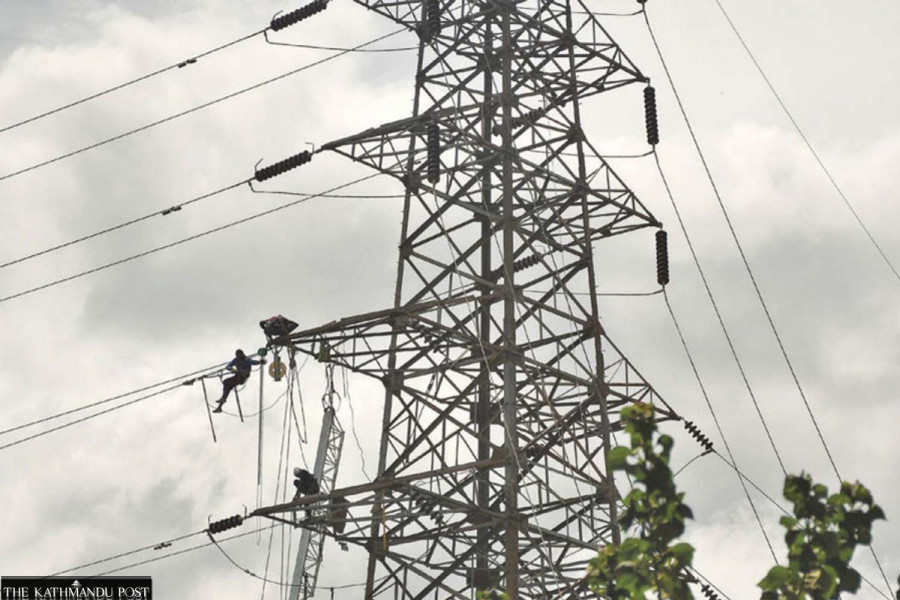
Nepal earned over Rs11 billion by selling excess power to India from early June to this week, the Nepal Electricity Authority said on Monday. The high income suggests electricity has emerged as a major export item.
In early November last year, India had for the first time allowed Nepal to sell electricity in the Indian market via a competitive bidding process. But after exporting for a few weeks, Nepal stopped selling power to India in December amid reduction in power generation in the dry season. Exports resumed this year with the start of monsoon in early June.
Initially, the southern neighbour had permitted Nepal to sell 39MW generated by the 15MW Trishuli and 24MW Trishuli hydropower projects.
However, Nepal was allowed to sell up to 364MW produced by six hydroelectric projects—140MW from the Kaligandaki Hydropower Project, 68MW from the Middle Marsyangdi, 67MW from the Marsyangdi and 51MW from Likhu-4 developed by the private sector, besides 37.7MW from Trishuli and Devighat hydropower projects— beginning early June this year.
In November this year, India allowed export of additional power from the 22.1MW Chilime Hydropower Project and 23.5MW. “Nepal has got approval to export 408MW from eight projects,” the NEA said in a statement.
The power utility body said it sold 1.35 billion units of electricity to the southern neighbour since resuming transfer in June. Earnings for the period stood at Rs11.16 billion as power was sold at the rate between Rs6.58 and Rs12.15 a unit.
It earned Rs2.83 billion from exports from July to the end of the last fiscal year 2021-22 and an additional Rs8.32 billion since the start of the new fiscal year 2022-23, according to the utility body. It aims to earn Rs16 billion within the current fiscal after resuming exports in May next year.
If the export target for the current fiscal year is met, the country is likely to become a net exporter of power. In the last fiscal year, the NEA imported power worth Rs15.46 billion. Along with growing power production in the country, the power import bill has been on a decreasing trend. In the previous fiscal year 2020-21, Nepal had imported electricity worth Rs21.82 billion, according to the NEA.
Nepal’s earning from electricity was the third largest from the export of a single commodity in the last fiscal year 2021-22.
Soybean oil topped the chart with exports worth Rs48.12 billion in the last fiscal year, followed by palm oil (Rs41.06 billion), according to the Trade and Export Promotion Centre (TEPC), a trade promotion agency under the commerce ministry.
Nepal earned as much as Rs11 billion by exporting yarns and Rs9.56 billion by exporting woollen carpet in the last fiscal year, according to the TEPC.
“Obviously, electricity has emerged as a big export product,” said Mohan Kumar Dangi, vice president of the Independent Power Producers Association of Nepal (IPPAN). “With more power projects set to be connected to the national grid, it has been necessary to explore the domestic and external markets.”
The NEA has projected an addition of 705MW to the country’s power system by the end of the current fiscal year 2022-23. Currently, Nepal’s power projects have an installed capacity of over 2,200MW.
The country faced power spillage this wet season owing to decreased demand at home and the Indian export cap of 408MW. “So, without increasing domestic demand and getting approval from India to export more, there is the possibility of more spillage next wet season,” said Dangi.
However, he hoped that India would be flexible and buy more as the southern neighbour has a policy of increasing the share of clean energy in its energy mix.
Nepal and India announced the Joint Vision Statement on Power Sector Cooperation in early April during Prime Minister Sher Bahadur Deuba’s visit to India. The statement talked about strengthening cooperation on joint development of power projects in Nepal, and the development of cross-border transmission infrastructure and bi-directional power trade with appropriate access to electricity markets in both the countries, based on mutual benefits.
The two countries have moved ahead to build the New Butwal-Gorakhpur Cross-Border Transmission Line, which will enable trade of more energy.
Dangi, however, insisted that the country needs to expand the domestic market for power by replacing fossil fuel, sell more to India and start exporting to Bangladesh as well.
For now, the NEA has stopped exporting to India amid a fall in output owing to reduced water levels in the snow-fed rivers where hydropower plants are based. Instead, the NEA has started importing power from India as domestic production is not enough to sustain high winter-time demands.
Nepal imported 4,477-megawatt hours of electricity from India on Monday.
Nepal has been decreasing electricity imports from its southern neighbour amid a gradual rise in domestic production. The total energy imported from India was 1,543 gigawatt-hours in the fiscal 2021-22 as compared to 2,806-gigawatt hours in the fiscal 2020-21, which is a decrease of 45.01 percent, according to the annual NEA.
The net import of electricity after the deduction of export was 1,050 gigawatt-hours, which accounts for only 9.49 percent of the total available electricity in FY 2021/22.
Kul Man Ghising, managing director of the NEA, said that the country might have to import power for four months. “But unlike in the past years, imports this year will be lower than exports,” said Ghising. “We will be a net exporter of power in terms of both volume of energy and earnings.”












